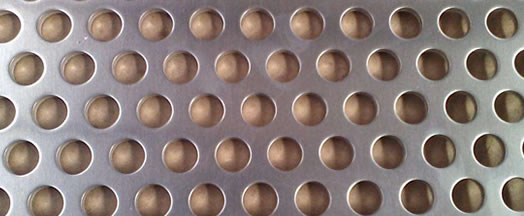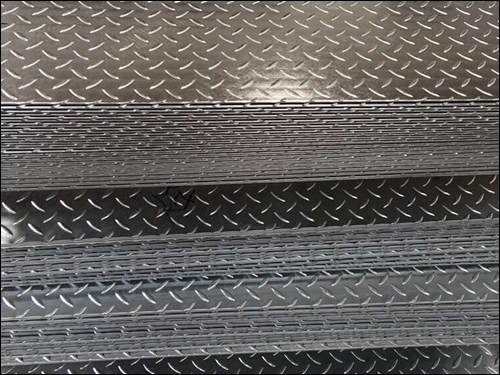Perforated Metal Styles

- Stainless Steel Staggered Sheet in Coil
- Diamond Hole Perforated Metal Panels
- Embossed Sheet Metal
- Slotted Hole Perforated Sheet
- Perforated Noise Barrier Panels
- Punched Slotted Tubes
- Perforated Acoustic Screen Panels
- Perforated Metal Sunshade Screen
- Perforated Metal Disc Filters
- Perforated Ceiling Panels
- Perforated Diffusers
- Perforated Ducting
- Perforated Louvers
- Checker Plate
- Round Hole Perforated Sheet
- Square Hole Perforated Sheet
- Semi-Circular Hole Metal Sheet
- Triangle Opening Metal Sheet
- Decorative Opening Metal Sheet
Perforated Materials:
- Perforated Sheet in Aluminum Powder Coated Black
- Perforated Metal Plates for Tubes
- Perforated Stainless Steel
- SUS 304 Punched Plate
- Aluminum Perforated Sheet
- Perforated Copper Sheet
- Mild Steel Perforated Metal
Perforated Metal Products
- Perforated Stainless Steel Sheets for Steam Strainers
- Perforated Stainless Steel Sleeves
- Dimple Perforated Sheet Steel Grating
- Stainless Steel Perforated Strainer Basket
- Perforated Stainless Steel Air Curtain Screen
- Perforated Screen Sheet in Stainless Steel
- Perforated Windproof Nets
- Perforated Vent Grille
- Polisher Screen
- Perforated Metal Grader Screen
- Perforated Stainless Steel Milling Screen
- Perforated Angle Bead
- Perforated Plate Sieves
- Slotted Filter Sheet
- Perforated Metal Coils
- Perforated Sheets
- Perforated Panels
- Perforated Metal Screen
- Perforated Steel Tube
- Perforated Filters
- Perforated Grilles
- Speaker Grille
- Perforated SS Tube
- Aluminum Perforated Strips
- Balustrade Panels
- Perforated Panel Railings
- Fire Escape Staircase
- Perforated Rack Panels
- Perforated Architecture Mesh
- Perforated Metal Security Screen
- Perforated Cable Tray
- Perforated Channel Cable Tray
- Checkered Tread Plate
Technical Terms:
- Perforated Metal Opening Patterns
- Applications of Perforated Sheet
- Materials Applied for Perforated Metal
- Benefits of Perforated Metal
- Calculation of Sheet Metal Weight
- Open Area Calculation
- Perforated Metal Definition
- Perforated Metal Features
- Terminology of Perforated Metal
Other Sheet Metals
Processing Machines

Stainless Steel and MS Checkered Tread Plates for Platform Floors and Safety Steps
Hengda Perforated Metal Factory excels in producing checkered tread plates. With advanced equipment and high-quality products, we have consistently exported to the United States, Germany, the UK, Australia, Canada, and beyond.
We always welcome global customers to contact us for information on product specifications, applications, customization, and quotes. At Hengda, we're eager to foster mutual growth and fruitful collaborations.
What is Checkered Tread Plate?
 Checkered tread plate, also known as diamond plate, floor plate, is a type of metal sheet with a regular pattern of raised diamonds or lines on one side. The patterns help reduce the risk of skidding, which is why these plates are often used for stairs, walkways, ramps, and the interior of ambulances.
Checkered tread plate, also known as diamond plate, floor plate, is a type of metal sheet with a regular pattern of raised diamonds or lines on one side. The patterns help reduce the risk of skidding, which is why these plates are often used for stairs, walkways, ramps, and the interior of ambulances.
When selecting a checkered tread plate, it's essential to consider the material, pattern, and thickness based on the specific needs of your application. If aesthetics are crucial, then the choice of metal and finish will also be significant. If it's for industrial use, then the durability, weight, and slip-resistance of the plate are of prime importance.
Material: Various metals including aluminum, steel, stainless steel, and more.
Pattern: The most common pattern is the diamond shape, five-bar, two-bar, one-bar, six bar and other shaped patterns are also available.
Thickness: The thickness of the plate varies depending on its use. Thinner plates might be used for decorative purposes, while thicker plates are used for more robust applications.
Uses:
- Industrial and Construction: For providing grip on stairs, walkways, ramps, and platforms.
- Vehicle Floors: Used in truck beds, ambulances, and fire trucks to provide grip.
- Decorative: Some people like the appearance of tread plates and use them in home design or on vehicle exteriors.
- Tool Boxes: For added durability and a rugged appearance.
- Gym Equipment: Sometimes used on weightlifting platforms or as part of certain gym equipment designs.
Checkered Tread Plates have following Advantages:
- Skid-Resistance: The primary purpose of the raised pattern is to provide grip and reduce the risk of slipping.
- Durability: These plates are durable and can withstand heavy wear and tear.
- Aesthetic Appeal: For some applications, the checkered pattern adds an aesthetic appeal.
- Easy to Clean: The pattern can help debris and dirt fall through or be easily brushed away.
Shortcomings:
- Weight: They can be heavier than flat plates, especially if made from steel or thicker metals.
- Not Completely Flat: The raised pattern means that these plates aren't entirely flat, which can be an issue for some applications.
Technical Info:
Standard width for checker tread plate for large production runs in various industries are:1000mm (about 39.37 inches)
1200mm (about 47.24 inches)
1250mm (about 49.21 inches)
1500mm (about 59.06 inches)
2000mm (about 78.74 inches)
Gauges:
Gauge refers to the thickness of metal sheet.
Common gauges (in terms of thickness) for checker tread plates, particularly for aluminum and steel. It's essential to understand that the gauge number inversely relates to the thickness of the metal; a smaller gauge number indicates a thicker metal:
Steel Tread Plates:
14 Gauge: 0.0747" or about 1.9mm
12 Gauge: 0.1046" or about 2.7mm
10 Gauge: 0.1345" or about 3.4mm
8 Gauge: 0.1644" or about 4.2mm
3/16" Plate: 0.1875" or about 4.8mm (often used for heavy-duty applications)
Again, the specific gauge or thickness you'll need depends on your application. For example, thicker plates are generally used for heavy-duty industrial applications, while thinner plates might be used for decorative purposes or lighter-duty applications.
Temper:
Temper in the context of metals refers to the process of hardening and strengthening the metal through heat treatment or cold working. For aluminum alloys, temper designations indicate the specific combination of processes used to produce a particular strength and ductility of the material.
H12, H14, H16, H18: These tempers have been strain-hardened. The number following the "H" indicates the degree of hardness, with H12 being the softest in this range and H18 being the hardest. As the hardness increases, formability decreases but strength increases. H22, H24, H26, H28: These are strain-hardened and partially annealed. Just like the H12-H18 range, the increasing number indicates increasing hardness.
For checker tread plates, you'll typically find tempers like H14, H22, and H24 as they offer a balance between formability and strength, making them suitable for forming into the raised checkered pattern while still providing durability.
What is MS Checkered Plate Heavy Duty?
MS stands for Mild Steel, which is a low-carbon steel. MS Checkered Plates are used in various applications, especially where slip resistance is required, such as platforms, staircases, walkways, and more. Heavy duty it implies the need for a thicker gauge and possibly a larger pattern to support heavier loads or resist more wear and tear.
Thickness: the thickness (or gauge) of the plate determines its strength and ability to bear loads. For heavy-duty applications, you'd typically look for thicker plates, such as:
5 mm
6 mm
8 mm
10 mm or even more
The specific thickness would depend on the exact requirements of your application.
Pattern Size: Larger patterns might be more suitable for heavy-duty applications as they can provide better load distribution and grip. However, this will also depend on the specific use-case scenario.
Finish: Depending on the environment, you might also want to consider finishes that can protect against rust, especially if the plate will be exposed to moisture. This can be achieved through galvanizing or applying protective coatings.
What is Stainless Steel Tread Plate?
Stainless steel tread plate, much like its counterparts made of aluminum or mild steel, is designed with patterns to provide slip resistance and is often used in industrial settings, walkways, ramps, stairs, and other areas where traction is important. The addition of chromium gives stainless steel its corrosion-resistant properties, making it especially useful in environments where corrosion is a concern.
Tread Designs:
- Diamond: This is one of the most common patterns and is characterized by small diamond-shaped projections.
- Five Bar: This pattern features five parallel, raised bars. The bars can be oriented in any direction, but they typically run lengthwise on the plate.
- Tear Drop: This pattern has a raised, teardrop shape. It provides good slip resistance and is aesthetically distinctive.
- Boomerang: A less common pattern, the boomerang design is characterized by a series of V-shaped or boomerang-like projections.
Grades:
- 304/304L: This is one of the most commonly used stainless steel alloys, mainly because of its excellent corrosion resistance. The "L" in 304L stands for "low carbon," which provides better weldability.
- 316/316L: This grade has added molybdenum, giving it even greater corrosion resistance, especially against chlorides like salt. It's especially useful in marine or high chloride environments. Again, the "L" in 316L stands for "low carbon."
- UNS S41003/1.4003: This is a grade of stainless steel that offers a good combination of corrosion resistance, strength, and weldability. It's a ferritic stainless steel, typically used in situations where lightweight, durability, and resistance to corrosion are paramount.
Material Thickness:
The thickness of the tread plate affects its strength, weight, and durability. Here are the listed thicknesses:
- 2mm: This is on the thinner side and would be suitable for lighter-duty applications or decorative purposes.
- 3mm: Suitable for moderate-duty applications.
- 4mm: More robust and can be used for heavier-duty purposes.
- 4.5mm: Slightly thicker than the 4mm, offering a bit more strength.
- 6mm: This is relatively thick and would be ideal for heavy-duty or industrial applications where strength and durability are key.